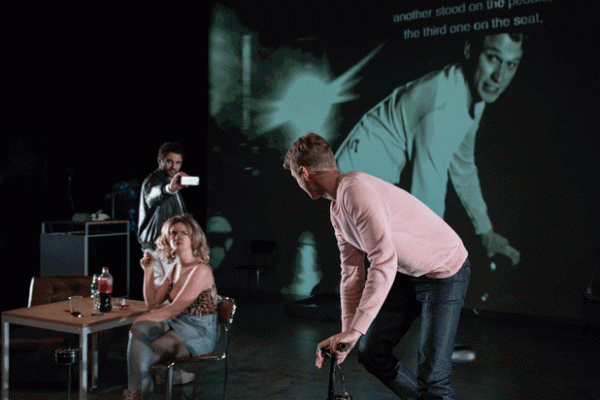
Thomas Ostermeier’s complex multimedia adaptation of Édouard Louis’s History of Violence features inventive camerawork (photo by Teddy Wolff)
St. Ann’s Warehouse
45 Water St.
Tuesday – Sunday through December 1, $46-$56
718-254-8779
stannswarehouse.org
www.schaubuehne.de/en
Thomas Ostermeier is one of the world’s most ingenious and unique theater directors, able to take a narrative and shape and twist it into something wholly unusual and unexpected. In 2017, his Schaubühne Berlin company, where he has been resident director since 1999, delivered a literally electrifying version of Richard III, while last year they brought their self-reflexive, multilayered Returning to Reims, based on Didier Eribon’s 2009 memoir, to St. Ann’s Warehouse. Ostermeier and Schaubühne are now back at St. Ann’s with History of Violence, a radical, highly inventive multimedia interpretation of the 2016 nonfiction novel by Édouard Louis, a close friend of Eribon’s; the bestselling book is based on a brutal attack Louis suffered on a Christmas Eve and its traumatic aftermath.
As the audience enters the theater, Édouard (Laurenz Laufenberg) is seated on a chair up against a large wall with a screen, looking exasperated. The play begins with three characters (Christoph Gawenda, Renato Schuch, and Alina Stiegler) conducting an intricate forensic investigation of a crime scene, in full protective gear like astronauts on the moon, using a cellphone camera and electric duster to find fingerprints as Édouard watches and Thomas Witte plays the drums stage left. The camera images are projected in stark, often uncomfortable close-ups on the rear screen; the video design is by Sébastien Dupouey, the coldly efficient, multifaceted set by Nina Wetzel.
Over the course of two intermissionless hours, the dark tale of what happened to Édouard is told in flashback, with Édouard, his sister, Clara (Stiegler), Clara’s husband, Alain (Gawend), and Édouard’s attacker, Reda (Schuch), either re-creating real-life scenes or speaking directly to the audience in the present through microphones, in both first and third person. Édouard openly shares the violation he experienced and the fear that has built up inside him, which has left him with an intense animosity for humanity. “I hated everyone. / I thought: / how can you. / That morning after Reda left, / I woke up with a strange taste in my mouth. / With the knowledge that I’d never / be able to bear the slightest trace / of anything that looked like happiness. / I could’ve slapped the next / smiling person I saw. / I’d have grabbed them by their lapels, / shaken them as hard as I could, / even children, / the frail or the disabled, / I’d have liked to shake them / and spit in their faces, / scratched them until I drew blood, / scratched their faces off, until all the faces disappeared.”
The reaction of the police and hospital personnel to the events results in a certain consternation because Édouard invited Reda to his apartment, while issues of class, sexual orientation, and race come to the fore. “The question wasn’t: / is he going to kill me? But rather: / how is he going to kill me?” Édouard explains, adding, “Later on the police and Clara / congratulated me for my bravery. / Nothing seems to me more alien to that night / than the concept of bravery.” At the hospital, he says, “I waited. / But nobody came. / I sat there feeling like / I was an extra in a story that wasn’t my own, / but had happened to someone else / that I didn’t know.”
A coproduction with Théâtre de la Ville Paris and Théâtre National Wallonie-Bruxelles, History of Violence is another audiovisual stunner from Ostermeier, who deserves the kind of attention that is lavished on Ivo van Hove, the Belgian multimedia mastermind. The show is part of a series of Louis-related events that included the BAM Next Wave presentation of a work based on his 2014 memoir, The End of Eddy, which ran at the Fishman last week and also deals with sex and power. History of Violence, which continues at St. Ann’s through December 1, is a work for our time, telling a poignant, deeply intimate true story using cutting-edge twenty-first-century techniques with an innovative style, holding nothing back as it explores trauma in extraordinary ways.